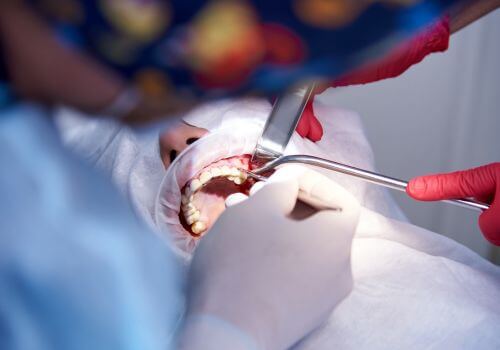Successful dental implant placement requires patients to have adequate bone volume and density. However, many people with missing upper back teeth lack sufficient bone due to maxillary sinus expansion or bone loss following tooth extraction. A sinus lift addresses this challenge, creating space for successful implant placement.
Sinus lift surgery is one of the most common procedures to prepare patients for dental implants in the upper jaw. It adds bone to your upper jaw between your maxillary sinuses and jaw on either side of your nose. Let’s take a closer look at this procedure and whether it might be right for you.
What Are Sinus Lifts?
A sinus lift (sinus augmentation) is a type of oral surgery in which a surgeon lifts the sinus membrane and adds bone graft material to increase bone volume. This builds a solid foundation for dental implants in the upper jaw, which often presents challenges due to thin bone and the proximity to the sinus cavity.
The maxillary sinuses sit above your upper teeth, and tooth loss can cause the sinuses to expand downward, leaving minimal bone for implant placement. Through careful manipulation of the sinus membrane and strategic bone grafting, this procedure establishes the necessary foundation for successful implants.
Why a Patient Might Need a Sinus Lift
There are several reasons your dentist might suggest a sinus lift before placing dental implants. Bone loss naturally occurs over time following tooth extraction, as the body reabsorbs bone no longer needed to support teeth. Periodontal disease can also deteriorate the jawbone, making implant placement difficult without additional support.
Some individuals are born with larger sinus cavities or thinner sinus walls, while others may have suffered facial trauma that damaged bone and requires reconstruction. In some cases, patients who’ve previously had unsuccessful implant attempts may need more bone to try again. It’s also common for patients who’ve delayed replacing missing teeth to experience significant bone loss, making implants unfeasible without augmentation.
For dental professionals, recommending a sinus lift involves a thorough assessment of both clinical needs and individual patient anatomy.

The Sinus Lift Procedure
A typical sinus lift follows these steps:
- Preparation: Your dental team cleans the surgical site and administers anesthesia.
- Accessing the sinus: An oral surgeon makes a small incision in the gum to expose the jaw bone.
- Creating a bone window: A small, oval window is carefully cut into the bone wall. Membrane elevation: The surgeon gently pushes the sinus membrane upward to create space.
- Bone graft placement: Grafting material fills the new space.
- Closing the site: The gum tissue is repositioned and sutured.
- Healing: The patient enters a healing phase lasting several months before implant placement.
Modern techniques have made this procedure more predictable and comfortable, with most patients reporting only minor discomfort during recovery. If you have any questions or concerns before or after your sinus lift, your dental team will assist you in any way possible.
Types of Sinus Lift Procedures
Dental surgeons typically follow one of two approaches to sinus augmentation. The lateral window technique is the traditional approach that involves creating an access window in the side wall of the sinus. This method allows direct visualization of the sinus membrane during elevation and permits significant bone augmentation, making it ideal for cases needing substantial bone volume.
The crestal approach is less invasive and involves accessing the sinus from the top of the ridge where the implant will eventually be placed. With this technique, dental professionals use specialized instruments to break the sinus floor and push it upward. Often, it can be performed simultaneously with implant placement. The crestal method works best for cases requiring minimal lifting. Your dental team will help you determine your best approach based on your anatomy and implant needs.
Grafting Materials Used in Sinus Lifts
Dentists use various grafting materials during sinus augmentation. Autogenous bone, harvested from your own body (typically from other areas of the jaw, chin, or hip), offers excellent biocompatibility but requires a second surgical site. Allografts, on the other hand, consist of human donor bone processed to be safe and sterile. They eliminate the need for a second surgical site while maintaining excellent bone-forming properties.
Xenografts, which come from other species (typically bovine), undergo processing to remove all organic components. They provide an excellent scaffold for new bone growth. Lastly, synthetic materials mimic natural bone mineral composition and offer consistent quality and unlimited supply without biological concerns. Many surgeons use combination approaches, mixing materials to harness the advantages of each type and create optimal conditions for bone formation.
Recovering After a Sinus Lift
After surgery, you will likely receive prescription antibiotics and pain medication to aid during recovery. Expect mild to moderate swelling, discomfort, and minor bleeding during the first 24-48 hours following your procedure. Discomfort and swelling should decrease by the end of the first week, though dietary restrictions (soft foods) and careful oral hygiene practices remain essential.
By weeks 2-4, initial soft tissue healing is well underway, and most patients can return to their regular diets and activities following an appointment to check healing progress. Complete healing spans several months, during which gradual bone maturation occurs. Your dentist will schedule period evaluations to monitor progress and begin preparing for implant placement once the bone has matured sufficiently. Most patients return to work within a few days.

Potential Risks and Complications
While generally safe and complications are rare, a sinus lift is a surgical procedure. As such, there are risks. In some patients, the thin sinus membrane tears during elevation, and every surgery carries a risk of infection. If your body doesn’t accept the grafting material, rejection can occur, and implant failure is possible if the graft doesn’t provide adequate support. Some patients also develop temporary or chronic sinus inflammation after this procedure.
Experienced surgeons can prevent these complications or effectively manage them if they occur. Proper case selection, refined surgical technique, and diligent aftercare substantially minimize risks. Discussing potential complications with your surgeon helps set realistic expectations and prepares you for the healing process.
Benefits of Getting a Sinus Lift
The Benefits of Sinus Augmentation
Sinus lift surgery offers significant advantages, making it a valuable option for patients who were once told they weren’t candidates for dental implants. By increasing bone volume in the upper jaw, this procedure opens the door to implant placement in areas that were previously unsuitable, while also boosting the long-term success rate of the implants themselves.
Beyond enabling implants, sinus augmentation helps restore natural form and function. Grafting encourages new bone growth, helping prevent further bone loss and preserving facial structure—reducing the sunken appearance that can come with missing teeth. With a stronger, more stable foundation, patients can enjoy natural-looking, long-lasting tooth replacements.
Thanks to its high success rate and predictable outcomes, sinus lift surgery has become a standard step in modern implant dentistry. If you've been told you don’t have enough bone for implants, a sinus lift could be the solution that brings your smile back. Schedule a consultation with a qualified dental professional to explore your options and take the first step toward restoring your smile.

